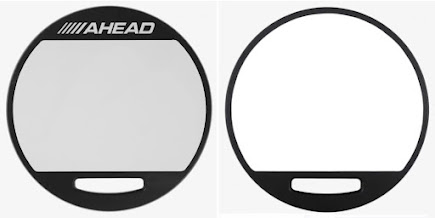When this pad was released six or seven years ago, I was mildly curious. The RCP Premium Pad was the company’s first offering, and a clear response to the Xymox Reserve Pad. Xymox’s pad was popular with HS and college marching drummers, but the company had serious issues with delivery and many hundreds of customers paid for pads they never received. One of those customers was the son of RCP’s founder.
RCP’s Premium pad is of a different design than the Xymox Reserve pad. For one thing, it weighs much less. It’s also made of a high-strength polyurethane that resists chipping and is much more durable than the thin rim found on the Xymox Reserve pad.
The Premium Pad offers a playing surface made of woven carbon fiber and aluminum. Underneath this you can choose from three different rubber or foam-rubber inserts of different thicknesses, each giving a slightly different sound and response. I haven’t been able to find out where the pad was manufactured.
The pad was priced comparably to other pads of its kind, roughly $100 for the 11” and $120 for the 13” size.
I wasn’t doing a lot of research on modern pads at the time, so I had only a passing interest.
A used 11” Premium Pad came up for sale at a price I could justify, so I bought it. It arrived earlier today.
Since my collection now includes more modern marching-focused pads (including a Xymox Reserve Pad), I was glad to add this to the stack.
Below are photos and videos of my pad.
The rim is held in place with anodized aluminum bolts that fit a drum key. They’re meant to be just slightly more than finger-tight, just enough to keep everything together; and provide NO adjustable tensioning.
Underneath the woven playing surface you can choose from one of three different inserts: tan gum rubber for a firmer feel, gray foam rubber for a medium feel, or orange foam rubber for a softer feel. The different between the inserts is subtle, but discernible.
I tried the pad with each of the inserts before finally settling on the orange insert, which provides good articulation and a nice response for the kind of playing I do. A pair of videos below provide a sense of some difference in sound, but really the greater difference can be felt in response as you play.
First, with the gray insert:
Then, with the orange insert:
Finally, with the gum rubber insert laid on top. (The pad doesn’t work well with more than one insert under the carbon layer at a time because of the precise fit involved.)
Interestingly, this pad apparently never sold in the same quantities as the Xymox pad did, even with Xymox’s horrible business practices. Eventually, RCP introduced what they call their Active Snare Pad, which is a Chinese-made HUN M-12 pad that’s been rebranded for several companies (including Salyers and others). It’s considerably more affordable than the Premier Pad, sold far better, and became the flagship of RCP’s pad line. Eventually the Premier Pad was quietly discontinued.
I emailed Robert Pettry at RCP to find out the timeline of the Premium Pad, and here's what he share with me:
BH:
When did this pad enter the market?
RP: May 2018.
|
|
BH: Who designed it and why? |
|
|
RP: Father and Son Brian and Robert Pettry designed this pad after a bad
experience with the company that starts with X. We wanted to over a
superior high quality product and offer good customer service and fast
turnaround. |
BH:
The pad does not appear at the RCP web site, and I'm wondering when it stopped being offered.
RP: After Covid we saw a large increase in material cost from our US Supply
companies and the cost to keep producing them was way to higher and we
didn’t want to raise the price any higher then they already were.
Following there we started outsource some of our
manufacturing to keep cost down not just for us but ultimately for the
students that buy our practice products. We started by partnering with
HanFlag to be the first company to bring this pad to the US Market.
Since then we have create a number of original
RCP Product Designs. One of the most popular being our trademarked
Pizza Pad.
BH: When did you discontinue the pad?
RP: May 2022
BH: Are any spares (laminates, inserts or lug bolts) still available?
RP: We have taken them down from our website but we do have a backup supply of hardware and laminates.
|
|
| So I am glad to
have found a used one at a good price to add to the stack. The bolts
are still working, though kind of beat-up. I may reach out to buy
replacements from them. |
|
|
RCP Drum Company can be found online
at their website, with links to Facebook and Instagram.



























